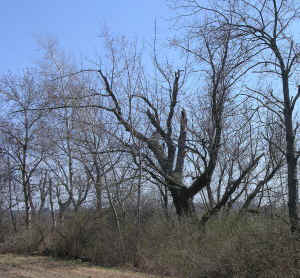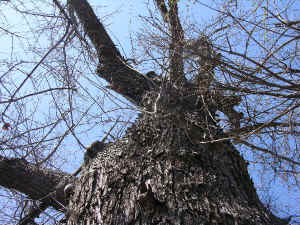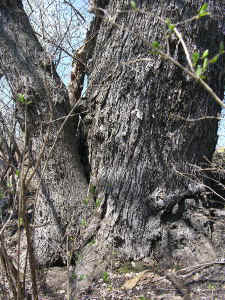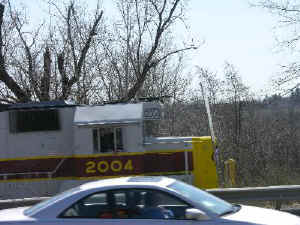| Old
Silver Maple |
Edward
Frank |
| Apr
03, 2007 17:29 PDT |
| There
is an old silver maple snag I pass on my way to work every
morning. I wonder of its history. The tree is perhaps 4 or 5
feet in diameter and stands not more than 40 feet high. It has
large broken-end limbs reaching upward giving it a skeletal
appearance, but most importantly, the tree is still alive. Today
there was a hint of red buds among the mass of finer limbs
heralding the approach of spring. It is located below a main
highway, adjacent to a set of railroad tracks, on the edge an
industrial park. The tree had not always been in such a sad
state, nor had it been growing under such an inhospitable
circumstances. I am guessing the tree is at least 150 years old,
perhaps a little more. It is growing on what had originally been
the edge of the flood plain of Sandy Lick Creek in Dubois, PA.

Early in its youth growing in a floodplain was an excellent
start for the tree. The Sandy Lick Creek is normally a small
steam. In the summer it may be as little as twenty feet across
and a foot deep. At other times the stream floods and overtops
its banks. Major floods have covered many of the little towns
along its path. In places the creeks flood plain is perhaps a
half-mile wide. In slow times it carries silt and clay sized
particles along. During floods larger rocks are
moved. The stream scours its bottom deepening it, only to be
filled back in again as the water recedes. When the floodwater
moving rapidly in the stream channel overtops the banks it
spreads out and slows. It drops the larger particles it is
carrying at the edge of the channel. Over time these eventually
form a raised levee along the edges of the river. From the top
of the levee the flood plain slopes backward toward the banks of
the floodplain itself. Water flowing from the channel during
floods, and small streams from the surrounding hillsides finds
itself trapped by the levee and forms backwater swamps along the
edge of the floodplain. These are areas ideal for the growth of
many trees such as out silver maple. If there is a large enough
volume of water these swamps will form stream that flow parallel
to the main river until it finds a breach in the levee that
allows it to join the main flow of the creek again. These are
called Yazoo streams and are known as such the world over. They
were named that after the Yazoo River in Yazoo City,
Mississippi. The Yazoo River is a large example of this type of
stream flowing parallel to the Mississippi River. Over time the
creek meanders back and forth across its flood plain, eroding
banks here and depositing bars there. Over time the meanders
move upstream in a slow march. How much of this was witnessed by
the old Silver Maple?

Land use changes were witnessed by the old Silver Maple. The
bottom of the floodplain was once covered by floodplain forests.
These were cut as the city of Dubois grew. By the early 1900's
almost all of William Penn's great woods was gone. The entire
state was denuded aside from a tiny patch here and there by
chance spared from the loggers saws. Sometime in the late 1800's
a railroad was built along the edge of the floodplain. Railroads
tended to follow the edges of floodplains as these had the low
slope needed for the pathway. Here and there along the route the
railroad bed was built up filling in parts of the backwater
swamp, or cut into the debris at the bas of the surrounding
hills. The tree likely outdates the railroad. It is near the
tracks but is not growing on the rubble of the railroad bed.
These trains were used to move coal across the country. At one
time the world's largest coal tipple was in Reynoldsville, PA a
few miles from the line from here. Still the old Silver Maple
has be exposed to over a hundred years of the roar of train
engines, the clackity clack of untold miles of trains, and the
belch of coal smoke and diesel fumes from tens of thousands of
trains.

The highway runs parallel to the train tracks past the tree. I
am sure that occasional horse drawn carriages were the norm in
the early years of the tree. Now thousands of cars pass by every
day. A convenience store was built a few years ago, along with
the associated stop light directly across the tracks and road
from the tree. The biggest changes witnessed by the tree was in
the floodplain itself. In the middle of the last century Sandy
Lick Creek was channelized as a flood control measure and large
portions of the floodplain swamps were drained to allow
development. Channelizing a stream is not a particularly
effective flood control method. The associated changes in land
use in the area, and loss the natural water retention in the
lost floodplain swamp assured that floods would continue. The
channel just made sure that areas downstream would have worse
floods on a more frequent basis than ever before. Yet people
persist even today with perplexing foolishness to build in
floodplains. They are called floodplains because this is where
the river floods. In the early 70's more of the floodplain was
drained. Ditches cut perpendicular to the stream reach to the
edges of the floodplain to drain the water for an industrial
park. One such ditch lies a hundred feet or so upstream of the
old Silver Maple. I am told that some other wetlands were
"constructed" to replace a portion of the drained
lands. The water regime in the vicinity of the old tree has been
forever changed.
At some point a series of silver maple trees were planted at the
edge of the floodplain. These run along the embankment parallel
to and below the railroad tracks just below the old Silver
Maple. They are spaced about twenty feet apart and have grown to
a foot or so in diameter since planted. There are gaps were some
of the trees have died and those remaining are broken and
bedraggled. Perhaps it was a beautification attempt undertaken
to hide the railroad tracks from the newly drained land.

The old Silver Maple tree is not the standard definition of
beauty. It is surrounded by shorter brush. The tree has large
broken limbs reaching above a fat trunk. What the tree has is
character. It shows its age and it shows the struggle it has had
for survival. It is a witness to of the history of change in the
area. It is a survivor from the past. In these way the tree is
indeed beautiful.
Edward Frank
|
| RE:
Old Silver Maple |
James
Smith |
| Apr
04, 2007 09:50 PDT |
Kind of sad recounting the supposed history of that old tree.
Outside of
an asteroid impact, has anything other than Mankind had such a
devastating and far ranging impact on this planet? |
| RE:
Old Silver Maple |
Matthew
Hannum |
| Apr
06, 2007 16:09 PDT |
Hmmm... Interesting coincidence since there's a different,
looming, old
broken-down silver maple I pass by each day to work, too.
This old tree grows along Quarterfield Road here in Maryland,
right next
to the road, near a run-down mobile-home or junk business. In
short, I
am not sure who "owns" it anymore, and it seems nobody
really cares
about, sadly. It sits across from a school, and kids pass by it
each
day, but I wonder if any of them appreciate it.
I measured the old beast in 2000, and it measred 14 feet, 5
inches
around the massive trunk, below the huge, sprawling limbs. By
then, the
crown was long dead and rotted, and the tree was hollow within,
but the
big, lower limbs were still alive and vigorous. In the years
since then,
one big limb either fell off or was removed, but the remaining
branch
still sets seed each spring and grows well during the summer.
The tree
may be a ruin, but it is still growing along.
There's no good way to tell how old the tree is - how fast do
silver
maples grow? And how long has it been a broken down wreck? I
moved down
here in 2000, and I honestly don't know of anyone who might
recall the
history of this tree, except maybe the crossing guard of the
school it
sits across from - maybe she knows? But it is probably quite
old, and
has seen a lot in its years. Now, it still fights on each year
(I hope
the late frost this year doesn't do it in) and acts as a home
for
assorted wildlife and a place for wild, fruit-bearing vines to
climb.
This old silver maple is not the only one in the area. Within a
mile
there are 2 others I know about, maybe more. One is an old wreck
along a
side street, and the 3rd is a towering, multi-trunk monster that
looms
over a local, family-run garden center. That tree is huge - at
the base,
it is easily over 7 or 8 feet across along the long-axis of the
oval,
but it multiple large trunks fused together, so it is not
"that big"
per say. At some point in its past, most of its limbs were pruned
back or
otherwise remove - sickening that such a giant would be
mutilated in
such a fashion, but maybe the city is to blame since it is near
a road.
The tree is now a strange collection of huge trunks and larger
limbs
each covered with leafy-shoots. Despite its size and mass,
however, it
is losing the war. It leaves out late and no longer sets seed
from what
I can tell.
Other large trees lurk in the area around here - a couple of
oaks, etc.
Who knows what they have all seen... sadly, so few people seem
to care!
|
| Re:
Old Silver Maple |
Edward
Frank |
| Apr
06, 2007 18:53 PDT |
Matthew,
Interesting story. I know Dale Luthringer is familiar with the
old silver
maple I talked about. We had talked briefly about it in some
other emails
late last year. The tree doesn't really
stand-out amidst the brush
surrounding it unless you are looking for trees. Maybe some more
people
notice it since the convenience store was built across the road
from it.
They can peruse the surroundings while pumping gas. I
am not sure how to
estimate the ages of Silver Maples. I am making a guess based
upon the look
of the bark and the size of the tree based upon other tree types
I have
seen. I am not sure if there are good age data for silver maple,
none in
the Eastern Old List, and I don't know if Dale of others on this
list have
cored them. I could be way off with my age guess.
The land use history I recounted for the area around the silver
maple is
true. I have not did detailed historical research to pinpoint
the dates,
but the ones I suggested are in the ballpark of actual events.
I wonder about silver maple. In its natural habitat it is
commonly subject
to breakage from flooding and similar events. You see it as a
multitrunked
tree commonly. These are signs of survival after the main trunk
was broken
off or damaged and the tree regrew. Many of the trees of which I
am
familiar are old broken looking trees. I wonder if it is the
nature of the
species to hang-on to life more so than some other tree species
so that more
of them survive to be old-looking half-dead snags? Is this part
of the
natural progression for the species, as opposed to many others
that look
perfectly healthy until the day the fall over? Comments anyone?
Ed Frank
|
| RE:
Old Silver Maple |
Matthew
Hannum |
| Apr
09, 2007 17:45 PDT |
You bring up a good point about silver maples in that they seem
to be
able to withstand extreme damage and other misfortune more so
than most
larger native American trees. Near total loss of the trunk, loss
of
large limbs, etc. Some of them don't even die immediately when
they fall
over if part of the roots are still in the ground and the tree
can send
out suckers from them. About the only other large tree I've seen
which
can withstand a similar beating and keep on going is the native
sycamore. Both of those species almost always keep going until
they are
a withered, gnarled snag that finally - with great reluctance -
gives up
the ghost.
It's too bad silver maples are so plagued with serious problems
like
limb failure and such that prevent them from living a long time
in most
cases. In the development where my parents live, silver maples
were the
tree of choice for the primary landscaping tree (houses built
back in
the 1960's). Sadly, I'd say over half of them are gone now. Many
fell
apart in storms or suffered one serious injury and started to
die back
or rot out. Even worse was the loss of a couple of perfectly
healthy
large ones for no apparent reason. My parents have one of the
largest by
far, with a huge nearly perfectly symmetrical crown. Still, I
have no
idea how long that tree will live and stay in one piece - with
silver
maples, it is always a gamble.
|
| RE:
Old Silver Maple |
wad-@comcast.net |
| Apr
09, 2007 18:01 PDT |
ENTS
I will be visiting two big silver maples on my way to Cook. One
is a single trunk and 22' cbh. The other is similar, but I
haven't seen a picture of it. They do tend to take a beating and
keep chugging away.
Scott
|
|